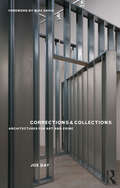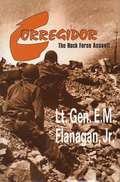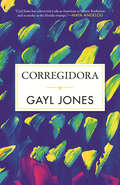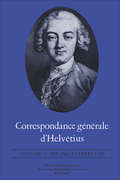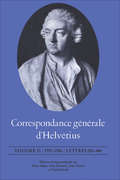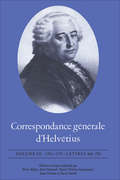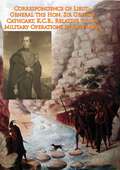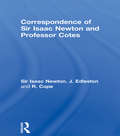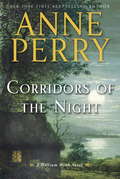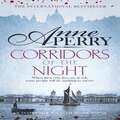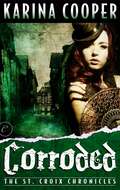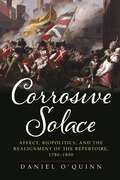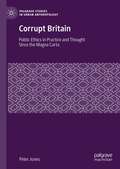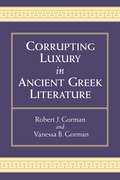- Table View
- List View
Corrections and Collections: Architectures for Art and Crime
by Joe DayAmerica holds more than two million inmates in its prisons and jails, and hosts more than two million daily visits to museums, figures which represent a ten-fold increase in the last twenty-five years. Corrections and Collections explores and connects these two massive expansions in our built environment. Author Joe Day shows how institutions of discipline and exhibition have replaced malls and office towers as the anchor tenants of U.S. cities. Prisons and museums, though diametrically opposed in terms of public engagement, class representation, and civic pride, are complementary structures, employing related spatial and visual tactics to secure and array problematic citizens or priceless treasures. Our recent demand for museums and prisons has encouraged architects to be innovative with their design, and experimental with their scale and distribution through our cities. Contemporary museums are the petri dishes of advanced architectural speculation; prisons remain the staging grounds for every new technology of constraint and oversight. Now that criminal and creative transgression are America’s defining civic priorities, Corrections and Collections will recalibrate your assumptions about art, architecture, and urban design.
Corregidor, The Rock Force Assault, 1945
by E. M. Flanagan"The two-week battle for Corregidor was complicated by the American's gross underestimation of enemy strength: expecting a few hundred demoralized defenders, they encountered more than 6,000 Japanese soldiers and marines deployed in tunnels and caves, every man dedicated to the Bushido code that dictated a fight to the death. As the dust was settling, MacArthur himself came ashore and was greeted by the commander of the victorious U.S. Army troops. 'Sir, ' said Col. George Jones, 'I present to you the Fortress Corregidor' -- a stirring conclusion to a dramatic and well-told story". -- Publishers Weekly
Corregidor: The American Alamo of World War II
by Eric MorrisTold in the voices of the soldiers, doctors, and nurses who were the untested but valiant defenders of Corregidor, the tiny island fortress of Generals Macarthur and Wainwright; Corregidor is the remarkable history of forty American and Filipino survivors. Before Pearl Harbor, American servicemen in the Philippines led a life of colonial ease. But from December 1941 to May 1942, defeated and humiliated by the Japanese and deceived by Washington, they fought and dies to buy America some desperately needed time to regroup and respond to the Japanese onslaught in the Pacific.
Corregidora (Celebrating Black Women Writers #1)
by Gayl JonesHere is Gayl Jones's classic novel, the tale of blues singer Ursa, consumed by her hatred of the nineteenth-century slave master who fathered both her grandmother and mother.
Correspondance générale d'Helvétius, Volume I: 1737-1756 / Lettres 1-249
by David Smith Alan Dainard Claude Adrien Helvétius Jean Orsoni Peter AllanThis volume is the first of three in a complete critical edition of the letters of Claude-Adrien Helvétius (1715-71) and his wife, née Anne Catherine de Liginville (1722-1800). Though rank and wealth, Helvétius was acquainted with the leading political and social figures of his time, and, through family, with court and government which he occasionally served in a diplomatic capacity. Philosopher and author of the explosive De l'esprit, Helvétius corresponded with the great and the influential throughout Europe. His letters, and those of Mme Helvétius, provide insights into, and new information about, their lives and the political, social, and intellectual history of the eighteenth century. Volume I contains almost 250 letters written by or to Helvétius or his wife. Of these, the largest collections are those from Helvétius to Mme Helvétius, made available by his descendants, and letters from the future Mmem Helvétius to her aunt, Mme de Graffigny, which are at Yale University. Letters to or from third parties are also included. Much of this correspondence has never before been published. Correspondance générale d'Helvétius is fascinating to read; it is indispensable for future study of Helvétius' life and work and of Mme Helvétius' influence on her husband his his circle. This volume has a preface by Comte Charles-Antoine d'Andlau, a descendant of Helvétius, and an introduction by the editors setting out their editorial and critical principles and system of annotation. (University of Toronto Romance Series 41)
Correspondance générale d'Helvétius, Volume II: 1757-1760 / Lettres 250-464
by David Smith Claude Adrien Helvétius Jean Orsoni Peter Allan Allan DainardThis second volume of the Correspondance générale d'Helvétius covers the period of the publication and reception of Helvétius' controversial first work, De l'Esprit (1758). It begins with a letter of January 1757, in which Helvétius recounts the attempt by Damiens on the life of Louis XV, and ends in December 1760 when the author, having been attacked on the stage of the Théatre-Francais but eulogized in foreign journals, is contemplating voluntary exile. In the meantime De l'Esprit provoked an uprecedented outcry from the court and from the religious and civil authorities. Denigrated as the epitome of all dangerous philosophic trends of the age, condemned as atheistic, materialistic, sacriligious, immoral, and subversive, it enjoyed an immense succes de scandale. Rather than examining the puzzles and paradoxes which surround the affaire de l'Esprit, this volume presents the documents upon which solutions may be based. Helvétius' own letters, often written hastily, under stress, and in fear they might be opened by the Cabinet noir, are less revealing than the letters between other protagonists in the affaire: the Cardinal de Bernis and the Duke de Choiseul, Jean-Omer Joly de Fleury, Malesherbes, Saint-Florentin, Tercier, and Louis xv himself. It is these letters, together with the appendixes containing edicts, retractions, an condemnations that shed new light not only on the development of the affaire but also on the complex workings of the ancien regime
Correspondance générale d'Helvétius, Volume III: 1761-1774 / Lettres 465-720
by David Smith Alan Dainard Claude Adrien Helvétius Jean Orsoni Peter Allan Marie-Thérèse InguenaudThe first two volumes of the Correspondance générale d'Helvétius inspired international acclaim. Now the third volume offers us further insight into a variety of aspects of life in eighteenth-century France.Claude-Adrian Helvétius (1715-71) was a wealthy and high-ranking member of French society. He was acquainted with the leading political and social figures of his time and, through family, with the court and government which he occasionally served in a diplomatic capacity. Philosopher, encyclopedist, and author of the explosive De l'Esprit, he and his wife, Anne Catherine de Ligneville, corresponded with the great and influential throughout Europe.The letters in this volume were written between 1761 and 1774, a period in which Helvétius enjoyed the fruits of his fame, travelled to England (1764) and Prussia (1765), and produced two books, Le Bonheur and De l'homme, which were published after his death.
Correspondance générale d'Helvétius, Volume IV: 1774-1800 / Lettres 721-855
by David Smith Claude Adrien Helvétius Jean Orsoni Peter Allan Marie-Thérèse Inguenaud J. A. DainardThis is the fourth of five volumes of the letters of the French philosopher Claude Adrien Helvétius (1715-1771), author of the controversial De l'Esprit (1758). Featuring the correspondence of Mme Helvétius, née Anne Catherine de Ligniville (1722-1800), in the years following her husband's death, this volume also includes letters by and to Helvétius discovered since the publication of the first three volumes. Mme Helvétius enjoyed an active widowhood, welcoming to her salon in Auteuil a group of intellectuals who came to be known as the Idéologues. A close friend of Benjamin Franklin, she was involved in political events before and during the French Revolution, as well as in Napoleon's coup d'état. In the last letter of the series her grandson describes her burial in her garden, which took place without religious or revolutionary ceremony in the presence of all her favourite pets. Most of the newly discovered letters are addressed to Helvétius by figures as important as d'Alembert, Boulanger, Chastellux, Saint-Lambert, Servan, Thieriot, and Trublet. Some of these complete an existing exchange, others provide dates for letters already published. The fifth and final volume will be devoted primarily to a comprehensive index. It will also include a chronological list of all the letters, corrections and modifications, and other useful material.
Correspondance générale d'Helvétius, Volume V: Appendices et Index
by David Smith Alan Dainard Claude Adrien Helvétius Jean Orsoni Peter Allan Marie-Thérèse Inguenaud Jonas SteffenThis fifth and final volume completes the critical edition of the letters of French philosopher Claude Adrien Helvétius (1715-1771), author of the controversial De l'Esprit (1758), and of his wife, née Anne Catherine de Ligniville (1722-1800), who ran her own salon in Auteuil after her husband's death. The essential component in this last volume is the detailed index – an indispensable instrument for researchers who wish to make full use of the correspondence. The volume also includes four new letters discovered since the appearance of the first four volumes, errata, additions and modifications to the critical apparatus, the text of letters excluded from the edition proper, genealogies of the families of Helvétius and his wife, and a chronological list of all letters mentioned in the edition. The previous volumes of this edition have enjoyed international acclaim. "All students of the French Enlightenment will be deeply indebted to D.W. Smith and his team for this superbly conceived and organized collaborative achievement. When complete the Toronto Helvétius will rank among the truly outstanding examples of twentieth-century editorial and bibliographical scholarship." (David Williams, French Studies)
Correspondence of Lieut.-General the Hon. Sir George Cathcart, K.C.B., Relative to his Military Operations in Kaffraria: Relative To His Military Operations In Kaffraria, Until The Termination Of The Kafir War, And To His Measures For The Future Maintenance Of Peace On That Frontier, And The Protection
by George Cathcart"Correspondence of Lieut.-General the Hon. Sir George Cathcart, K.C.B., Relative to his Military Operations in Kaffraria" is a compelling and detailed collection of letters and reports penned by Sir George Cathcart, providing an invaluable firsthand account of his military campaigns in the region known as Kaffraria during the mid-19th century.Sir George Cathcart, a distinguished British Army officer, played a pivotal role in the Cape Frontier Wars, a series of conflicts between the British Empire and the Xhosa people in what is now the Eastern Cape of South Africa. This book compiles his extensive correspondence, offering readers a direct insight into the strategies, challenges, and experiences of a high-ranking military commander during this tumultuous period.Through these letters, Cathcart meticulously details his military operations, including troop movements, engagements with the enemy, and the logistical and strategic considerations that shaped his decisions. His correspondence not only highlights the tactical aspects of warfare but also provides a vivid portrayal of the landscapes, environments, and cultural encounters that defined his campaigns."Correspondence of Lieut.-General the Hon. Sir George Cathcart…" is an essential resource for historians, military scholars, and anyone interested in the colonial history of South Africa. The book's rich primary source material provides a nuanced and detailed understanding of the Cape Frontier Wars and the broader context of British imperial military operations.With its meticulous documentation and firsthand perspective, this book stands as a significant contribution to the historical record, offering readers an authentic view of the experiences and challenges faced by one of Britain's notable military figures in the 19th century.
Correspondence of Sir Isaac Newton and Professor Cotes: Including Letters Of Other Eminent Men Now First Published From The Originals In The Library Of Trinity College, Cambridge; Together With An Appendix, Containing Other Unpublished Letters And Papers
by Sir Isaac Newton J. Edleston R. CopeFirst Published in 1969. This is an exact facsimile reproduction of the 1850 edition of Edleston’s Correspondence of Sir Isaac Newton and Professor Cotes. An index, prepared under the General Editor’s supervision, has been added at the end of the volume.
Correspondence, 1939 - 1969: 1923 - 1966
by Gershom Scholem Theodor W. AdornoAt first glance, Theodor W. Adorno’s critical social theory and Gershom Scholem’s scholarship of Jewish mysticism could not seem farther removed from one another. To begin with, they also harbored a mutual hostility. But their first conversations in 1938 New York were the impetus for a profound intellectual friendship that lasted thirty years and produced more than 220 letters. These letters discuss the broadest range of topics in philosophy, religion, history, politics, literature, and the arts – as well as the life and the work of Adorno and Scholem’s mutual friend Walter Benjamin. Unfolding with the dramatic tension of a historic novel, the correspondence tells the story of these two intellectuals who faced tragedy, destruction, and loss, but also participated in the efforts to reestablish a just and dignified society after World War II. Scholem immigrated to Palestine before the war and developed his pioneering scholarship of Jewish mysticism before and during the problematic establishment of a Jewish state. Adorno escaped Germany to England, and then to America, returning to Germany in 1949 to participate in the efforts to rebuild and democratize German society. Despite the differences in the lifepaths and worldviews of Adorno and Scholem, their letters are evidence of mutual concern for intellectual truth and hope for a more just society in the wake of historical disaster. The letters reveal for the first time the close philosophical proximity between Adorno’s critical theory and Scholem’s scholarship of mysticism and messianism. Their correspondence touches on questions of reason and myth, progress and regression, heresy and authority, and the social dimensions of redemption. Above all, their dialogue sheds light on the power of critical, materialistic analysis of history to bring about social change and prevent repetition of the disasters of the past.
Correspondence: 1923 - 1966
by Siegfried Kracauer Theodor W. AdornoTheodor W. Adorno and Siegfried Kracauer were two of the most influential philosophers and cultural critics of the 20th century. While Adorno became the leading intellectual figure of the Frankfurt School, Kracauer’s writings on film, photography, literature and the lifestyle of the middle classes opened up a new and distinctive approach to the study of culture and everyday life in modern societies.This volume brings together for the first time the long-running correspondence between these two major figures of German intellectual culture. As left-wing German Jews who were forced into exile with the rise of Nazism, Adorno and Kracauer shared much in common, but their worldviews were in many ways markedly different. These differences become clear in a correspondence that ranges over a great diversity of topics, from the nature of criticism and the meaning of utopia to the work of their contemporaries, including Bloch, Brecht and Benjamin. Where Kracauer embraced the study of new mass media, above all film, Adorno was much more sceptical. This is borne out in his sharp criticism of Kracauer’s study of the composer Offenbach, which Adorno derided as musically illiterate, as well as his later criticism of Kracauer’s Theory of Film. Exposing the very different ways that both men were grappling intellectually with the massive transformations of the 20th century, these letters shed fresh light on the principles shaping their work at the same time as they reveal something of the intellectual brilliance and human frailties of these two towering figures of 20th century thought. This unique volume will be of great value to anyone interested in critical theory and in 20th century intellectual and cultural history.
Corridors of Power: The Politics of Environmental Aid to Madagascar
by Catherine A. CorsonA highly regarded academic and former policy analyst and consultant charts the forty-year history of neoliberalism, environmental governance, and resource rights in Madagascar Since the 1970s, the U. S. Agency for International Development has spent millions of dollars to preserve Madagascar's rich biological diversity. Yet its habitats are still in decline. Studying forty years of policy making in multiple sites, Catherine Corson reveals how blaming impoverished Malagasy farmers for Madagascar's environmental decline has avoided challenging other drivers of deforestation, such as the logging and mining industries. In this important ethnographic study, Corson reveals how Madagascar's environmental program reflects the transformation of global environmental governance under neoliberalism.
Corridors of the Night: A William Monk Novel
by Anne PerryAnne Perry, that incomparable novelist of life in Victorian England, has once again surpassed herself, with this twenty-first installment of her New York Times bestselling William Monk series. In Corridors of the Night, nurse Hester Monk and her husband, William, commander of the Thames River Police, do desperate battle with two obsessed scientists who in the name of healing have turned to homicide. The monomaniacal Rand brothers--Magnus, a cunning doctor, and Hamilton, a genius chemist--are ruthless in their pursuit of a cure for what was then known as the fatal "white-blood disease." In London's Royal Naval Hospital annex, Hester is tending one of the brothers' dying patients--wealthy Bryson Radnor--when she stumbles upon three weak, terrified young children, and learns to her horror that they've been secretly purchased and imprisoned by the Rands for experimental purposes. But the Rand brothers are too close to a miracle cure to allow their experiments to be exposed. Before Hester can reveal the truth, she too becomes a prisoner. As Monk and his faithful friends--distinguished lawyer Oliver Rathbone and reformed brothel keeper Squeaky Robinson among them--scour London's grimy streets and the beautiful English countryside searching for her, Hester's time, as well as the children's, is quickly draining away. Taut with intrigue and laced with white-knuckled terror, Corridors of the Night is Anne Perry at her magnificent, unforgettable best.
Corridors of the Night: A twisting Victorian mystery of intrigue and secrets (William Monk Mystery #21)
by Anne PerryWhen their own lives are at risk, some people will do anything to survive... Corridors of the Night is the twenty-first exceptional historical thriller featuring William and Hester Monk, from the Queen of Victorian crime Anne Perry. Perfect for fans of C. J. Sansom and Sarah Perry.'Pulls no punches and depicts Victorian London in all its corrupt glory' - Bookreporter One night, in a corridor of the Royal Naval Hospital, Greenwich, Nurse Hester Monk is approached by a terrified girl. She's from a hidden ward of children, all subject to frequent blood-letting, and her brother is dying.While William Monk's River Police fight to keep London safe from gun-runners, Hester takes on a new role at the hospital, helping to administer a secretive new treatment. But she slowly realises that this experimental cure is putting the lives of the children at risk. Attempting to protect the young victims, she comes under threat from one rich, powerful, and very ill man who is desperate to survive... What readers are saying about Corridors of the Night: 'I truly could not put this book down. The suspense had me in the edge of my seat and the subject matter had me hooked!''A riveting mystery wrapped up in the dark and seamy side of Victorian London''Anne Perry is the best Victorian crime [writer] I have ever read'
Corridors of the Night: A twisting Victorian mystery of intrigue and secrets (William Monk Mystery #21)
by Anne PerryOne night, in a corridor of the Royal Naval Hospital, Greenwich, nurse Hester Monk is approached by a terrified girl. She's from a hidden ward of children, all subject to frequent blood-letting, and her brother is dying. While William Monk's River Police fight to keep London safe from gun-runners, Hester takes on a new role at the hospital, helping to administer a secretive new treatment. But she slowly realises that this experimental cure is putting the lives of the children at risk. Attempting to protect the young victims, she comes under threat from one rich, powerful, and very ill man who is desperate to survive...
Corrie ten Boom's Prison Letters
by Corrie Ten Boom"Love never fails." This message is emphasized time and again within the letters, diary entries, and personal sketches that Corrie and Betsie ten Boom wrote during their months in prison and concentration camps. The ten Booms' story, told in THE HIDING PLACE and TRAMP FOR THE LORD, is clarified in the communications sent and received during the Underground workers' imprisonment--inspiring, encouraging correspondence that continually proclaims God's love, even in the midst of trial.
Corroded: Book Three of The St. Croix Chronicles
by Karina CooperBook three of The St. Croix ChroniclesHungry for vengeance, Cherry St. Croix is forced to the fog-ridden streets of Victorian London.My rival, a collector of bounties like myself, has murdered one of my own. In consequence, I have been removed from my house, my staff and all who would support me. I have nowhere else to turn, so I beg asylum within the Midnight Menagerie, London's decadent pleasure garden.Micajah Hawke's dominance there will not tolerate my presence for long. I am fixated on revenge, but I walk a razor's edge under his scrutiny. His wicked power is not easily ignored, and I must not allow myself to submit-no matter how sweet the sacrifice.Challenging my rival to a race is the only way to end this-no small task when the quarry is the murderous Jack the Ripper. As my enemies close in, I fear the consequences of this hunt. I am trapped between two killers, and what doesn't kill me may leave its scars forever.
Corrosive Solace: Affect, Biopolitics, and the Realignment of the Repertoire, 1780-1800
by Daniel O'QuinnIn Corrosive Solace, Daniel O’Quinn argues that the loss of the American colonies instantiated a complex reorganization in sociability and politics in the British metropole that has had long-lasting effects on British national and imperial culture, which can be seen and analyzed within its performative repertoire. He examines how the analysis of feeling or affect can be deployed to address the inchoate causal relation between historical events and their mediation. In this sense, Corrosive Solace’s goals are twofold: first, to outline the methodologies necessary for dealing with the affective recognition of historical crisis; and second, to make the historically familiar strange again, and thus make visible key avenues for discussion that have remained dormant. Both of these objectives turn on recognition: How do we theorize the implicit affective recognition of crisis in a distant historical moment? And how do we recognize what we, in our present moment, cannot discern?Corrosive Solace addresses this complex cultural reorientation by attending less to “new” cultural products than to the theoretical and historical problems posed by looking at the transformation of “old” plays and modes of performance. These “old” plays—Shakespeare, post-Restoration comedy and she-tragedy—were a vital plank of the cultural patrimony, so much of O’Quinn’s analysis lies in how tradition was recovered and redirected to meet urgent social and political needs. Across the arc of Corrosive Solace, he tracks how the loss of the American War forced Britons to refashion the repertoire of cultural signs and social dispositions that had subtended its first empire in the Atlantic world in a way more suited to its emergent empire in South Asia.
Corrupt Britain: Public Ethics in Practice and Thought Since the Magna Carta (Palgrave Studies in Urban Anthropology)
by Peter JonesThis book deploys a long-term account of political corruption in Britain to explain the phenomenon of corruption as it resides within the state and the contemporary problem of corruption denial among members of the political class. It aims to satisfy the concern about corruption and identify potential causes and significance. The book provides and account of definitions of corruption and how those definitions have changed over time. Throughout the succeeding chapters it discusses public life and how ethical considerations for public office holders have evolved over time. This book argues that corruption is not just a concern about politics and understanding corruption requires a multi-disciplinary approach: history; political science; sociology; anthropology and urban ethnography.
Corrupted Science: Fraud, Ideology and Politics in Science (Revised & Expanded)
by John GrantA searing exposé of the misuses and misrepresentations of science from the time of Galileo continuing through to the present day, this new edition includes updates on the asbestos industry, the chemicals industry, the sugar industry, the agriculture industry (the abuse of antibiotics), and the automobile industry (lead in gasoline). The final chapter has been expanded to include the full-blooded assault on science mounted by the Trump administration.
Corrupting Luxury in Ancient Greek Literature
by Vanessa B Gorman Robert GormanA widely accepted truism says that luxury corrupts, and in both popular and scholarly treatments, the ancient city of Sybaris remains the model for destructive opulence. This volume demonstrates the scarcity of evidence for Sybarite luxury, and examines the vocabulary of luxury used by the Hellenic world. Focus on the word truphe reveals it means an attitude of entitlement: not necessarily a bad trait, unless in extreme form. This pattern holds for all Classical evidence, even the historian Herodotus, where the idea of pernicious luxury is commonly thought to be thematic. Advancing a new method to evaluate this fragmentary evidence, the authors argue that almost all relevant ancient testimony is liable to have been distorted during transmission. They present two conclusions: first, that there exists no principle of pernicious luxury as a force of historical causation in Hellenic or Hellenistic literature. Rather, that idea is derived from early Latin prose historiography and introduced from that genre into the Greek writers of the Roman period, who in turn project the process back in time to explain events such as the fall of Sybaris. The second conclusion is methodological. The authors lay down a strategy to determine the content and extent of fragments of earlier authors found in cover texts such as Athenaeus, by examining the diction along synchronic and diachronic lines. This book will appeal to scholars of intellectual history, the history of morality, and historiographical methodology.
